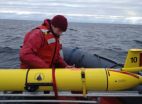(Press-News.org) Two robots equipped with instruments designed to "listen" for the calls of baleen whales detected nine endangered North Atlantic right whales in the Gulf of Maine last month. The robots reported the detections to shore-based researchers within hours of hearing the whales (i.e., in real time), demonstrating a new and powerful tool for managing interactions between whales and human activities.
The team of researchers, led by Woods Hole Oceanographic Institution (WHOI) scientists Mark Baumgartner and Dave Fratantoni, reported their sightings to NOAA, the federal agency responsible for enforcing the Marine Mammal Protection Act. NOAA Fisheries Service, in turn, put in place on Dec. 5 a "dynamic management area," asking mariners to voluntarily slow their vessel speed to avoid striking the animals.
The project employed ocean-going robots called gliders equipped with a digital acoustic monitoring (DMON) instrument and specialized software allowing the vehicle to detect and classify calls from four species of baleen whales – sei, fin, humpback, and right whales. The gliders's real-time communication capabilities alerted scientists to the presence of whales in the research area, in the first successful use of technology to report detections of several species of baleen whales from autonomous vehicles.
The oceanographic research project was underway from Nov. 12 through Dec. 5, operating in an area called the Outer Fall, about sixty miles south of Bar Harbor, Me., and 90 miles northeast of Portsmouth, NH. Right whales are thought to use this area every year between November and January as a mating ground.
Two gliders were deployed by Ben Hodges and Nick Woods, also of WHOI, on Nov. 12 from the University of New Hampshire's 50-ft research vessel, the Gulf Challenger. The vehicles surveyed the area for two weeks, sending data to the researchers every two hours via satellite, prior to the scientific team's arrival Nov. 28 on the University of Rhode Island's research vessel Endeavor. The gliders continued to survey for another week before being recovered by the Endeavor on Dec. 4. "We put two gliders out in the central Gulf of Maine to find whales for us," says Baumgartner, who specializes in baleen whale and zooplankton ecology. "They reported hearing whales within hours of hitting the water. They did their job perfectly."
Using the gliders's reconnaissance data and continued real-time updates, the science team was able to locate whales in just a few hours of searching. "We found our first right whale on the first day that we were surveying in decent weather conditions because the gliders were up there doing the leg work for us, to tell us where the animals were in real time," says Baumgartner.
The innovative whale detection system provides conservation managers with a cost-effective alternative to ship- or plane-based means of identifying the presence of whales, and gives whale ecologists new tools for understanding large animals that spend most of their lives out of human eyesight below the sea surface.
Whale researchers want to learn what draws whales to this part of the ocean during the late fall and winter. However, high winds and rough seas typical of that time of year make studying the animals very difficult.
"This presents a huge knowledge gap," says Baumgartner.
The labor-intensive work of surveying for whales, overseen by NOAA, is usually done by human observers on ships or airplanes, and is limited by the conditions at sea.
"We've been doing visual based surveys for a long time – either from a plane or a boat. They have a lot of value, but they are limited, especially at certain times of the year," says Sofie Van Parijs, leader of the Passive Acoustic Research Group at NOAA's Northeast Fisheries Science Center (NEFSC). "These gliders provide a great complement to this system. Knowing where right whales are helps you manage interactions between an endangered species and the human activities that impact those species."
The success of the project is a result of years of productive collaboration among engineers, biologists and physical oceanographers at WHOI, scientists at the NEFSC Protected Species Branch in Woods Hole, and federal funders like the Office of Naval Research and NOAA's Applied Science and Technology Working Group Program. The gliders are operated by Fratantoni, a physical oceanographer; the DMON acoustic monitoring instrument was developed by WHOI engineers Mark Johnson and Tom Hurst; and Baumgartner, who has nearly a decade of experience identifying whale calls, wrote software for the DMON to enable it to recognize unique calls of sei, fin, humpback, and right whales, and to keep a tally of when and where it heard each call. By integrating the DMON into Fratantoni's gliders, the team had the ability to search large areas of the ocean and to receive data in real time.
"No one of us could've done this project alone. But by teaming up, we created a really nice group of people with expertise that was tailor made for this problem," says Baumgartner. "Now, we can know that there's an animal in a particular part of the ocean within hours of a call being made, as opposed to months later," when the instruments have finally been retrieved and the data has been reviewed.
Gliders – approx. six-foot-long, torpedo-shaped autonomous vehicles with short wings – have been in use by oceanographers for about a decade. They move up, down, and laterally in a sawtooth pattern through the water by changing their buoyancy and using their wings to provide lift. Battery powered and exceptionally quiet in the water, the gliders are equipped with an underwater microphone on the underside of the vehicle near its wings, and an iridium satellite antenna on the tail section. The vehicle surfaces every few hours to get a GPS position and transmit data to shore-side computers.
The DMON – a circuit board and battery about the size of an iPhone – sits inside the glider recording audio and generating spectrograms, a form of the audio that facilitates complex sound analysis. From the spectrogram, Baumgartner's software generates a "pitch track," a visual representation of a whale call, and estimates which species of whale made the call based on characteristics of the pitch track. Tallies of each species' detected calls and even a small subset of detected pitch tracks can be transmitted to shore by the vehicle. "Each pitch track takes less than 100 bytes, whereas transmitting just one of those calls as an audio clip would take about 8000 bytes of data," says Baumgartner. This makes the system efficient and economical. And, adds Baumgartner, it's also really flexible. It is easy to update the software to include a larger repertoire of whale calls into the software's "call library."
In addition to demonstrating the utility of the robots for the management and conservation of baleen whales, the project also has ongoing scientific objectives. One goal of the shipboard research team, in addition to spotting the whales, was to take measurements and collect biological samples of the tiny crustaceans or zooplankton upon which the whales feed, in an effort to characterize the oceanic conditions and to understand how those conditions impact the whale's food and ultimately attracts whales to the study area. "Untangling how that happens is a big deal," says Fratantoni.
"We wanted to figure out what right whales were feeding on in this area," says Baumgartner. "We took profiles of the temperature and the salinity of the water and sampled zooplankton throughout the water column to understand what might make this area attractive to right whales." Analysis of these data is in progress now.
Additional team members included representatives from the New England Aquarium who maintain a catalog of right whales and are experts in identifying individual right whales from patches of thickened skin on their heads, called callosities. Through their efforts, the team recognized four of the individual whales sighted during their week on the research ship -- two males born in 2006, one male born in 2004, and one female born in 2008.
INFORMATION:
The Woods Hole Oceanographic Institution is a private, non-profit organization on Cape Cod, Mass., dedicated to marine research, engineering, and higher education. Established in 1930 on a recommendation from the National Academy of Sciences, its primary mission is to understand the ocean and its interaction with the Earth as a whole, and to communicate a basic understanding of the ocean's role in the changing global environment.
Scientists use marine robots to detect endangered whales
2013-01-09
ELSE PRESS RELEASES FROM THIS DATE:
Drug resistance: 'Baby steps' can pay off big
2013-01-09
HOUSTON -- (Jan. 9, 2013) -- Rice University scientists have found that mutations of small effect can turn out to be game changers in the bacterial fight against antibiotic drugs.
The discovery came during an exhaustive, three-year effort to create a mathematical model that could accurately predict how specific mutations allow bacteria like E. coli to adapt to antibiotics like minocycline. The findings are detailed in a Dec. 10 study in the Proceedings of the National Academy of Sciences.
"As biologists, we tend to focus on big effects that result from big changes, ...
Hold the diet soda? Sweetened drinks linked to depression, coffee tied to lower risk
2013-01-09
SAN DIEGO – New research suggests that drinking sweetened beverages, especially diet drinks, is associated with an increased risk of depression in adults while drinking coffee was tied to a slightly lower risk. The study was released today and will be presented at the American Academy of Neurology's 65th Annual Meeting in San Diego, March 16 to 23, 2013.
"Sweetened beverages, coffee and tea are commonly consumed worldwide and have important physical—and may have important mental—health consequences," said study author Honglei Chen, MD, PhD, with the National Institutes ...
Study shows cognitive benefit of lifelong bilingualism
2013-01-09
Washington, DC — Seniors who have spoken two languages since childhood are faster than single-language speakers at switching from one task to another, according to a study published in the January 9 issue of The Journal of Neuroscience. Compared to their monolingual peers, lifelong bilinguals also show different patterns of brain activity when making the switch, the study found.
The findings suggest the value of regular stimulating mental activity across the lifetime. As people age, cognitive flexibility — the ability to adapt to unfamiliar or unexpected circumstances ...
Nobel laureate James Watson publishes novel hypothesis on curing late-stage cancers
2013-01-09
Cold Spring Harbor, NY – "Although mortality from many cancers has been steadily falling, particularly those of the blood [i.e., leukemias], the more important statistic may be that so many epithelial cancers (carcinomas) and effectively all mesenchymal cancers (sarcomas) remain largely incurable."
With these words as preface, Nobel laureate James D. Watson, Ph.D., in a newly published paper that he regards "among my most important work since the double helix," sets forth a novel hypothesis regarding the role of oxidants and antioxidants in cancers that are currently ...
Vitamin D supplementation does not reduce knee pain, cartilage loss in patients with osteoarthritis
2013-01-09
CHICAGO – In a two year randomized trial, patients with symptomatic knee osteoarthritis who received vitamin D supplementation did not have a significant difference in knee pain or cartilage volume loss compared to patients who received placebo, according to a study appearing in the January 9 issue of JAMA.
"Knee osteoarthritis (OA) is a common age-related musculoskeletal disorder that has significant functional impact and has considerable societal costs through work loss, early retirement, and arthroplasty. Despite its impact, there are no medical treatments established ...
Study documents failure rate of antibiotic treatment for gonorrhea
2013-01-09
CHICAGO – In an examination of the effectiveness of cefixime, the only oral cephalosporin antimicrobial recommended for treatment of Neisseria gonorrhoeae (gonorrhea) infections, researchers found a clinical treatment failure rate of nearly 7 percent for patients treated at a clinic in Toronto, according to a preliminary study published in the January 9 issue of JAMA.
"Because of Neisseria gonorrhoeae resistance to all prior first-line antimicrobial agents, cephalosporin [antibiotic] therapy with adjuvant azithromycin or doxycycline is recommended for treatment of gonorrhea," ...
Post-operative intravenous acetaminophen may help reduce use of morphine in infants
2013-01-09
CHICAGO – Among infants undergoing major surgery, postoperative use of intermittent intravenous paracetamol (acetaminophen) for the management of pain resulted in a lower cumulative morphine dose over 48 hours, according to a study appearing in the January 9 issue of JAMA.
Opioid therapy for the treatment of pain is associated with adverse effects. Researchers are seeking alternative analgesic regimens in neonates and infants, according to background information in the article. Paracetamol has been proposed as an alternative, with one study showing promise.
Ilse Ceelie, ...
Lung cancer patients live longer if they use beta-blockers while receiving radiotherapy
2013-01-09
Patients with non-small-cell lung cancer survive longer if they are taking beta-blockers while receiving radiotherapy, according to a study of 722 patients published in the cancer journal Annals of Oncology [1] today (Wednesday).
Researchers at the University of Texas MD Anderson Cancer Center (Houston, USA) reviewed the progress and outcomes of patients who had received radiotherapy as their main or first line of treatment for cancer (known as "definitive radiotherapy" i.e. radiotherapy that is delivered at doses of 60 Gy or more, with the intention of curing the disease). ...
Cheating slime mold gets the upper hand
2013-01-09
A 'cheater' mutation (chtB) in Dictyostelium discoideum, a free living slime mould able to co-operate as social organism when food is scarce, allows the cheater strain to exploit its social partner, finds a new study published in BioMed Central's open access journal BMC Evolutionary Biology. The mutation ensures that when mixed with 'normal' Dictyostelium more than the fair share of cheaters become spores, dispersing to a new environment, and avoiding dying as stalk cells.
Dictyostelium have an unusual life style. They generally live as individual amoeboid cells, eating ...
Triple mix of blood pressure drugs and painkillers linked to kidney problems
2013-01-09
Patients who take a triple combination of blood pressure drugs and common painkillers are at an increased risk of serious kidney problems, especially at the start of treatment, finds a study published on bmj.com today.
Although the absolute risk for individuals is low, it is still something doctors and patients should be aware of, say the researchers.
Acute kidney injury (also known as kidney failure) is a major public health concern. It occurs in more than 20% of hospital inpatients and is associated with around half of all potentially preventable deaths in hospital. ...


